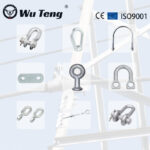
Products
All types of power fittings and accessories
Power fittings connect and combine power system devices, transmit mechanical loads, electrical loads, and provide protective functions.
Electric power fittings are metal accessories that connect and combine various devices in the power system, playing a role in transmitting mechanical loads, electrical loads, and providing some form of protection. According to the national standard GB/T5075-2001 “Terminology for Power Hardware”, power hardware is an important component of the power system, used to fix, connect, connect, and protect wires, ensuring the normal operation and safety of the power system.
There are various types of power fittings with different purposes. Common electrical fittings include:
Wire clamp: used for installing wires.
Hanging ring: forms an insulator string.
Compression tube and repair tube: Connect wires.
Spacer: Various types of spacers on split conductors.
Cable fittings: Various types of cable fittings used for towers.
Busbar fittings: Busbar fittings used for distribution equipment in substations and power plants.
Electric power fittings play a crucial role in power grid construction. They not only transmit mechanical and electrical loads, but also play a protective role, ensuring the stable operation of the power system. For example, in transmission and distribution lines, power fittings include conductors, lightning rods, insulators, towers, guy wires, and foundation grounding devices, which are the main components that make up the power grid.
The development history of power fittings is long, and with the advancement of power grid technology, their types and functions are constantly expanding. In summary, power fittings play an indispensable role in the power system, with various types and functions, playing an important role in ensuring the stable operation and safety of the power system.









